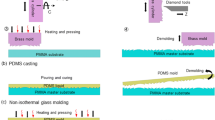Abstract
This paper describes the development of an affordable precision hybrid glass–polymer achromatic doublet fabricated by microinjection molding. This hybrid lens can be used to correct chromatic aberration by combining a flint and a crown glass. Specifically, polycarbonate was selected as the flint glass with higher dispersion and N-BK7 was selected for lower dispersion crown glass. Microinjection molding was utilized to apply the aspherical polycarbonate layer directly onto the N-BK7 glass lens’ surface in this study for its capabilities of precision microfeature replication and mass production. In addition, finite element-based numerical simulation for molding process was employed to assist the design to improve the manufacturability. To ensure high precision in the fabricated hybrid lens, mechanical alignment features were created on the mold inserts to position the finished polymer lens along with the insert that housed the glass lens. The mold inserts’ surfaces were diamond-turned to optically finished without polishing. It was demonstrated in this study that with properly designed manufacturing processes, an integrated hybrid glass–polymer lens could be fabricated without further mechanical alignment. Lastly, the optical performance of the hybrid lens was verified by focal shift evaluation.
Similar content being viewed by others
References
Doushkina V (2010) Innovative hybrid optics: combining the thermal stability of glass with low manufacturing cost of polymers. Proc SPIE 7788:778809
Herzberger M, McClure NR (1963) The design of superachromatic lenses. Appl Opt 2(6):553–560
Kim SW, Turng LS (2006) Three–dimensional numerical simulation of injection molding filling of optical lens and multiscale geometry using finite element method. Polym Eng Sci 46(9):1263–1274
Laikin M (2006) Lens design. CRC, Boca Raton
Li L, He P, Wang F, Georgiadis K, Dambon O, Klocke F, Yi AY (2011) A hybrid polymer–glass achromatic microlens array fabricated by compression molding. J Opt 13(5):055407
Lim J, Choi M, Kim H, Kang S (2008) Fabrication of hybrid microoptics using UV imprinting process with shrinkage compensation method. Jpn J Appl Phys 47:6719–6722
Lu X, Khim LS (2001) A statistical experimental study of the injection molding of optical lenses. J Mater Process Technol 113(1):189–195
Park K, Joo W (2008) Numerical evaluation of a plastic lens by coupling injection molding analysis with optical simulation. Jpn J Appl Phys 47:8402–8407
Valley P, Savidis N, Schwiegerling J, Dodge MR, Peyman G, Peyghambarian N (2011) Adjustable hybrid diffractive/refractive achromatic lens. Opt Express 19(8):7468–7479
Yang C, Su LJ, Huang CN, Huang H-X, Castro JM, Yi AY (2011) Effect of packing pressure on refractive index variation in injection molding of precision plastic optical lens. Adv Polym Technol 30(1):51–61
Yi AY, Jain A (2005) Compression molding of aspherical glass lenses—a combined experimental and numerical analysis. J Am Ceram Soc 88(3):579–586
Yi AY, Li L (2005) Design and fabrication of a microlens array by use of a slow tool servo. Opt Lett 30(13):1707–1709
Zwiers RJM, Dortant GCM (1985) Aspherical lenses produced by a fast high-precision replication process using UV-curable coatings. Appl Opt 24(24):4483–4488
Web references
Edmund Optics (2012) http://www.edmundoptics.com/learning-and-support/technical/learning-center/application-notes/optics/why-use-an-achromatic-lens/?&pagenum=2. Accessed Dec 2012
Author information
Authors and Affiliations
Corresponding author
Rights and permissions
About this article
Cite this article
Li, L., Yi, A.Y. An affordable injection-molded precision hybrid glass–polymer achromatic lens. Int J Adv Manuf Technol 69, 1461–1467 (2013). https://doi.org/10.1007/s00170-013-5128-1
Received:
Accepted:
Published:
Issue Date:
DOI: https://doi.org/10.1007/s00170-013-5128-1



